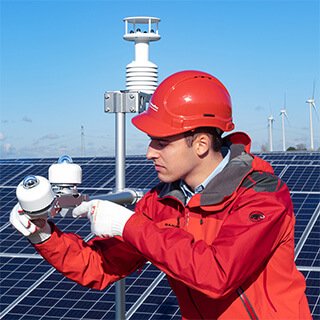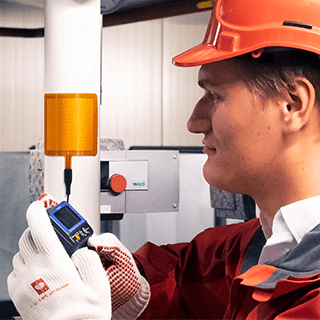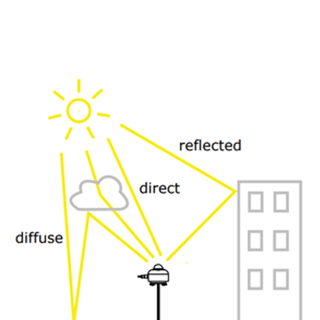What is a thermopile?
Thermopiles are sensors that convert a temperature difference into a voltage. They are essential components in Hukseflux’s heat flux sensors and pyranometers, and essentially are the parts that perform the measurements. This article explains how these thermopile sensors work. First, it discusses thermocouples, which are the building blocks of thermopiles. Then, using this information, we explain how thermopiles work. Finally, the application of thermopiles is briefly explained using the example of a pyranometer.
Thermocouple measurement
A thermocouple is used to perform a temperature measurement by converting the temperature difference into a voltage. A thermocouple consists of two metals with different electrical conductivity that form a junction. A voltage is produced when there is a temperature difference at the junction of these materials. This voltage is a result of the ‘Seebeck effect’. The magnitude of this voltage is defined as follows:
![]()
Here ∆V is the generated voltage [V], S1 and S2 are the Seebeck coefficients of the two metals [V/K], and ∆T is the temperature difference [K]. For a single thermocouple, the voltage can be measured with a schematic setup, as shown in Figure 1.
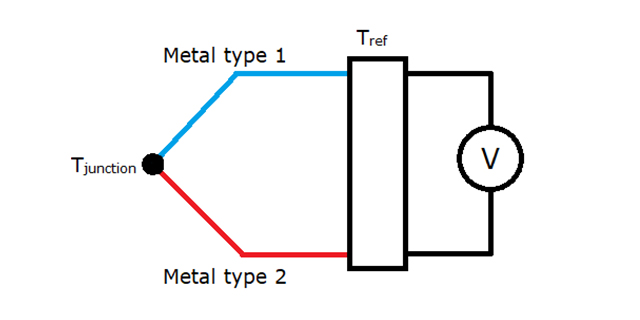
As shown, the two metals are connected at two locations. On the left side, we have the previously mentioned junction. Here, the temperature to be measured is located, Tjunction. The second connection of the two metals is at a junction held at a known temperature, Tref. Due to the different Seebeck coefficients of the two metals, a produced voltage can be measured. When S1 and S2 are known, a value for the temperature difference ∆T can be determined, which, in this example, is the difference between Tjunction and Tref. Tref is measured using a temperature sensor in the measurement equipment, and the absolute temperature Tjunction can then be calculated.
However, the voltage difference produced by this thermocouple is often in the millivolt range. Therefore, accurately measuring this can be challenging, and uncertainties can be quickly introduced.
To overcome this, multiple thermocouples can be connected in series to form a thermopile sensor, which will be discussed in more detail in the following section.
Thermopile sensor
The purpose of a thermopile is not to measure an absolute temperature, but a temperature difference. This temperature difference is typically proportional to a heat flux flowing through the thermopile and the material in which it is embedded.
As mentioned above, a thermopile sensor is created by placing many thermocouples in series. The generated voltage difference scales linearly with the number of thermocouples (N) and the temperature difference across the sensor ∆T (across the thermal resistance layer in Figure 2, as defined by the following equation:
![]()
This amplification [N] creates a sensor that is more sensitive to a change in temperature difference than one single thermocouple.
Figure 2 shows a schematic overview of a part of a thermopile sensor.
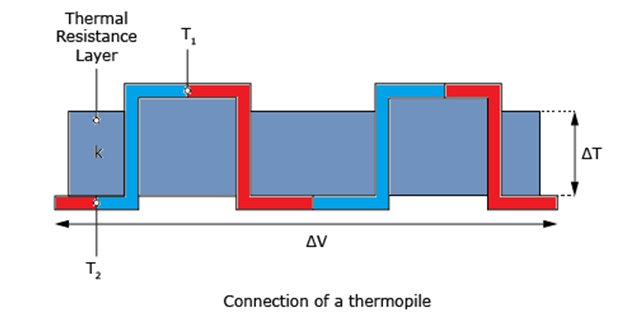
metal types connected in series, embedded in a “thermal resistance layer”.
The thermal resistance layer creates a thermal barrier between the two surfaces, ensuring the temperature difference is not zero. So again, like the thermocouple, the temperature difference induces a voltage output. This can be measured. If the Seebeck coefficients and the thermal resistance are known, this measurement can be converted to a temperature difference or heat flux measurement. The temperature difference is now measured over the top and bottom of the thermopile sensor (T1 and T2). In practice, the sensor properties and the properties of the thermal resistance layer are not known in detail, and a heat flux sensor is calibrated by a test in which it is exposed to a known heat flux.
Furthermore, an advantage of the Seebeck effect must also be noted. Given that the characteristics of the material properties cause it, the resulting voltage difference is a passive process, meaning no external power is required.
Now that thermopile sensors have been explained, the following section will show an example of their application: pyranometers.
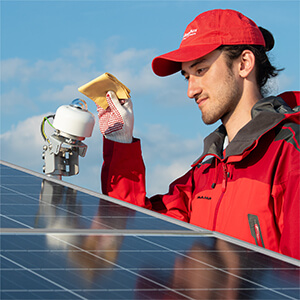
containing a thermopile sensor to measure
the solar irradiance.
Pyranometer
The previous sections showed how thermocouples allow a temperature difference to be converted into a voltage output. The most obvious use of these sensors is for temperature difference and heat flux measurements. Hukseflux, therefore, uses them in their heat flux sensors to provide high-accuracy measurements. However, thermopile sensors can also be found in other Hukseflux products. For example, they can be found in our pyranometers.
In Figure 3, the industrial pyranometer SR300-D1, Hukseflux’s most accurate pyranometer, is shown.
This pyranometer contains a thermopile sensor, which allows it to quantify solar irradiance. Specifically, a black-coated thermopile is used. When sunlight reaches the sensor, the black coating absorbs the energy stored in light, converting it to thermal energy or heat. This leads to a temperature difference between the hot side of the thermopile, that of the black coating, and the cold side, which is glued to the pyranometer body. This is again converted into a voltage through the Seebeck effect.
Through calibration, the voltage output can be associated with solar radiation. This is usually done by comparing it to a reference pyranometer under a lamp that emits “solar” radiation. This calibrated pyranometer can now be used to measure solar radiation accurately. This is useful for various applications such as PV system performance monitoring and climatological studies. More information on how pyranometers work can be found in the article What is a pyranometer?
Conclusion
In this article, the question “What is a thermopile?” has been answered. This was done by first examining thermocouples, which are the building blocks of thermopile sensors.
Thermocouples perform measurements by converting a temperature difference into a voltage output using the Seebeck effect. To increase the sensitivity of the measurement, thermocouples can be connected in series to obtain a thermopile sensor. By measuring the thermopile’s voltage output, temperature differences and heat fluxes can be accurately quantified. Hukseflux produces heat flux sensors that can accurately measure these quantities using thermopile sensors.
More information on Hukseflux’s heat flux sensors and their measurements can be found in the article: How to measure heat flux?
Furthermore, thermopile sensors can be found in Hukseflux’s pyranometers, enabling them to measure solar radiation accurately.
If you are interested in knowing more about this topic, check out our other articles in the library or contact us for personal help with any questions you might have!








